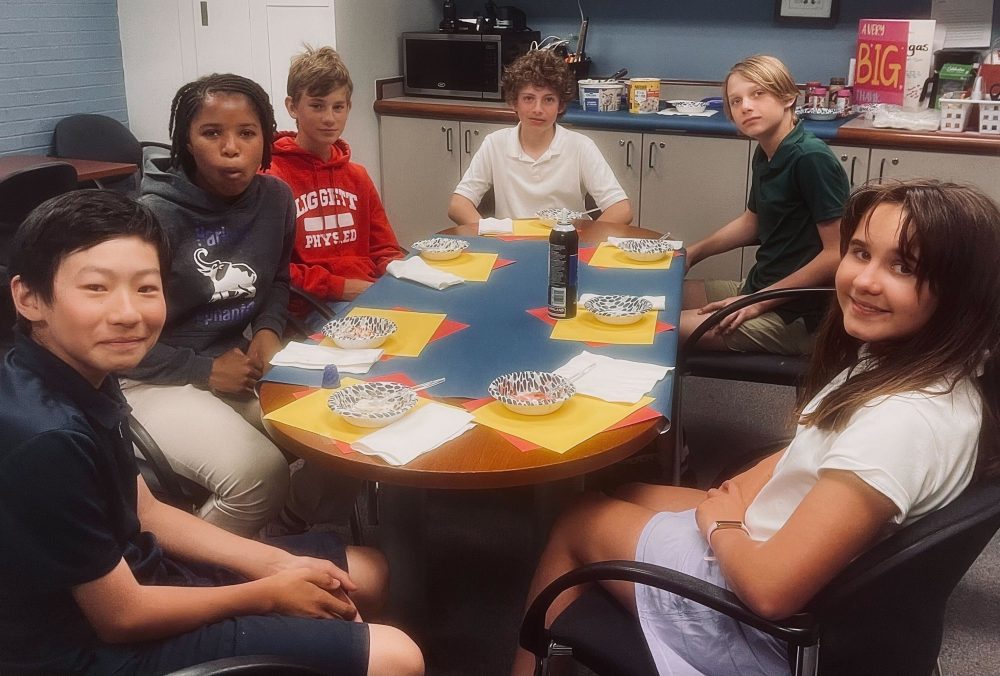Creating a Cohort Model to Boost Engagement and Connection
When the GOA course design team set out to redesign the popular Computer Science I: Computational Thinking course for students in grades 6-8, they knew they would need to make thoughtful adjustments to help younger learners thrive.
Eliza Griscom, who taught the middle school CS I course this past year, explains that the redesign “required thoughtful consideration of how younger learners engage with programming concepts differently than high schoolers.” Updates also included adapting content and outcomes to use more accessible language, reducing the number of external tools and platforms to minimize friction points while navigating the course, and increasing synchronous teacher-student interactions to foster deeper connection and support.
Creating a Local Cohort Model
University Liggett School took GOA’s middle school course redesign a step further by creating an in-person cohort of students who met regularly during a shared elective block. In a middle school elective catalog largely focused on the arts, the computer science course offered a new opportunity to expand STEM offerings. Liggett librarian and teacher Karen Villegas stepped in to support this inaugural group of six students, providing on-site guidance and structure.
Although the Liggett students worked side by side three times a week, they were enrolled in two different sections of the course and participated online alongside peers from across the globe. They participated in weekly synchronous sessions, where students from different schools and time zones connected to share their work, ask questions, and collaborate in real time. “These live connections proved invaluable for building community and maintaining engagement in an online environment,” says Griscom. Liggett’s blend of in-person support and global connection created a flexible, student-centered experience tailored to the developmental needs of learners in grades 6-8.
Villegas believes this faculty-supported cohort-based approach was central to her students’ success. “If schools can create the opportunity for students to work on their online course while being supervised, at least at first, I think that was a key to our success,” she says. “Middle schoolers forget stuff. They have busy schedules. Kids — just by the nature of kids, right? — lose track of what they’re supposed to do or when they’re supposed to do it.”

University Liggett School, Computer Science I: Computational Thinking, Middle School Cohort
Navigating Challenges and Growth
Villegas says some Liggett students thrived with the independence of an online course, while others benefited from the added structure and guidance she provided. She collaborated closely with Griscom to coordinate a synchronous schedule that accommodated both her students and those at other schools — a challenging task for a middle school student. In addition Villegas was able to offer day-to-day support: guiding students through Canvas (like reminding them to click “Next” at the bottom of a page or check dropdown menus for additional content), helping them stay on top of assignments while juggling trimester shifts, extracurriculars, and family travel, and reinforcing the habits needed to succeed in a more independent learning environment. All things that are, she says, “typical for middle school.”
Attention to detail, organizational skills, and simply learning from a new online format caused some students to “hit a few speed bumps along the way,” Villegas says. She remembers one student who, in general, had a difficult time keeping up with his coursework: “He started to get frustrated because in our middle school, when you're in a face-to-face class, you can get more flexible extensions on your work. And that was an adjustment for him,” she says. “When he eventually reflects back he'll say, ‘That's the course that made me pay attention more. I wish more people would have made me pay attention more.’”
Some students came to the course with previous coding experience, while others were exploring it for the first time. Not all of them fell in love with the subject — and that’s okay. While they enjoyed aspects of the course, a couple of students realized, “‘Yeah, I’m probably not going to do coding for a living,’” Villegas says. “But they hung in there and did what they needed to do” to be successful.
Griscom agrees: “Even students with no prior programming experience gained confidence and began thinking like computer scientists — breaking down complex problems and recognizing how these skills apply far beyond computer science,” she says.
Local and Global Connections
The in-person cohort often collaborated informally, helping one another troubleshoot and navigate the course. This not only supported their technical growth but also helped them build essential skills like problem-solving and knowing when to ask for help — skills that will serve them in high school and beyond.
“There was one project where they had to build a game, and they were all playing each other’s games, giving each other feedback,” Villegas says. “They all got along really well, so that worked out nicely. They could ask each other for help if something wasn't working or if they didn't know where to find an assignment — they could get their face-to-face needs met, so to speak.”
That layered model — online and in-person, local and global — is exactly what GOA’s middle school computer science course was designed to support.
“I was consistently impressed by the level of engagement students brought to our synchronous sessions,” Griscom says. “And I was particularly moved by how supportive they were of peers from other schools and locations during both live meetings and asynchronous discussions. Watching middle schoolers cheer each other on as they shared their website and app prototypes or troubleshooted Python programs together reminded me why this age group is so special. They’re naturally curious, generous with encouragement, and eager to learn from one another.”
For more, see:
From Curiosity to Community: GOA Student Ambassadors Reflect on Transformative Learning
Reimagining Professional Learning: Emerging Models for Educator Growth
Personalized Pathways Programming at International School of Prague
The Extraordinary Together series spotlights stories and outcomes from our member schools, illustrating the impact GOA programs have on students, educators, and schools. Posts in the series highlight the potential of student-centered learning—demonstrating how learners thrive when schools foster curiosity and provide pathways for pursuing passions—and they showcase the tangible ways we partner with schools to drive meaningful change. By sharing these experiences, we seek to illuminate how school membership amplifies our member schools' mission, sparks innovation, and shapes the future of education.
GOA is a nonprofit learning organization that reimagines learning to empower students and educators worldwide. In partnership with our global network of 150 schools, we provide interactive, relationship-driven courses, expert resources, and innovative thinking that help to expand and elevate academic programs. Together, we help students and educators become open to the extraordinary.
Follow us on LinkedIn for the latest learning opportunities and news. Sign up for GOA Insights, our newsletter focused on innovative ideas and best practices for the future of learning. Become a Member School.


